Blogs

Understanding Beryllium Alloys: A Complete Tutorial on Properties and Applications
Introduction
In the realm of advanced materials, beryllium alloys stand out for their remarkable properties and diverse applications, making them a cornerstone in industries ranging from aerospace to electronics. The unique characteristics of beryllium copper alloys, such as their lightweight nature, exceptional strength, and thermal stability, position them as essential components in high-performance environments. As procurement managers navigate the complexities of sourcing materials, understanding the fundamental properties, manufacturing processes, and regulatory standards associated with beryllium alloys becomes crucial.
This article delves into the multifaceted advantages of beryllium alloys, explores their practical applications across various sectors, and highlights the necessary health and safety considerations to ensure compliance and protect workers in potentially hazardous environments. By equipping themselves with this knowledge, procurement professionals can make informed decisions that enhance operational efficiency and safety in their organizations.
Fundamental Properties of Beryllium Alloys
Beryllium Copper mixtures, especially those provided by DOMADIA, are noted for their remarkable characteristics, rendering them essential in numerous high-performance uses:
- Lightweight: Beryllium Copper stands out as one of the lightest structural metals, a characteristic that is pivotal for sectors where weight savings are paramount. This is vital for uses in aerospace, where advanced materials are leveraged for enhanced performance.
- High Strength: Despite its minimal weight, Beryllium Copper possesses remarkable mechanical strength and rigidity, being the strongest of all copper mixtures. This exceptional load-bearing capacity makes it ideal for challenging uses, from aerospace components to precision instruments.
- Thermal Stability: Beryllium Copper mixtures are known for their ability to retain strength and dimensional stability across a broad temperature range. This ensures consistent performance in high-temperature environments, making them a reliable choice for critical applications.
- Corrosion Resistance: The materials demonstrate strong resistance to corrosion, greatly enhancing their longevity across various uses. This property is particularly advantageous in environments where materials face harsh conditions, ensuring longevity and reliability.
- Good Electrical Conductivity: Beryllium Copper mixtures are excellent conductors of electricity, making them highly valuable in the electronics industry. Their use in components such as connectors and switches underscores their efficiency and reliability.
DOMADIA offers a diverse range of Beryllium Copper products, including plates, rods, and custom shapes, all compliant with international standards (UNS, ASTM). Our commitment to quality and customer satisfaction is reflected in our rigorous manufacturing processes and responsive customer service. Grasping these essential characteristics allows procurement managers to strategically assess how Beryllium Copper compositions can satisfy particular usage needs, ensuring optimal performance and longevity. Testimonials from satisfied clients emphasize the reliability and effectiveness of our products in various industrial uses.
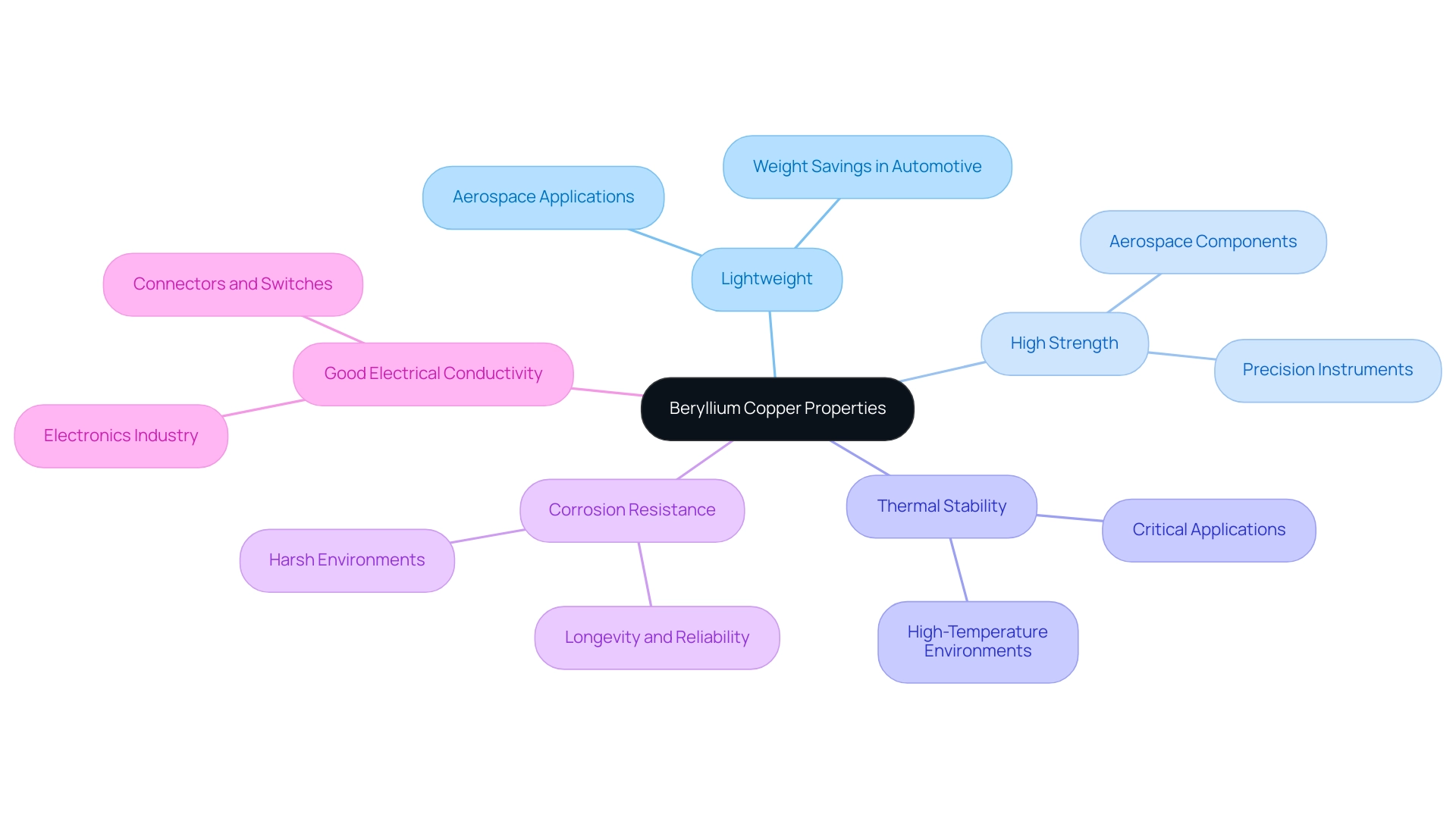
Applications of Beryllium Alloys in Industry
Beryllium mixtures provide a flexible array of uses in different sectors, each gaining from their distinct characteristics:
Aerospace: Beryllium mixtures are indispensable in aerospace applications, particularly in components that demand high strength-to-weight ratios. They are extensively used in structural parts and satellite components, contributing significantly to fuel efficiency and overall performance. Beryllium Copper Round Bar 172, characterized by its non-magnetic, non-sparking, strong, hard, and wear-resistant attributes, is a prime example. These properties make it ideal for critical environments where safety and reliability are paramount. Notably, Beryllium Copper Round Bar 172 has a minimum elongation of 20%, further enhancing its suitability for dynamic aerospace applications.
Electronics: The outstanding electrical conductivity and thermal stability of these metal mixtures make them highly suitable for electronic connectors and switches. This enhances the reliability and longevity of electronic devices. In the electronics sector, these metal mixtures hold a significant market share due to their exceptional conductive characteristics. Real-world examples include their use in high-performance circuit boards and connectors that require minimal signal loss.
Military: Specific metal mixtures are essential for missile systems and aerospace components where performance and reliability cannot be compromised. The non-sparking and strong nature of Beryllium Copper Bars, compliant with specifications like AMS 4533 and ASTM B196, ensures their suitability for such high-stakes environments. Case studies highlight their use in critical military systems, where failure is not an option.
Medical Equipment: Precision instruments and imaging devices in the healthcare sector benefit greatly from the lightweight and strong physical characteristics of beryllium-based materials. Their application in medical devices underscores their importance in achieving high precision and reliability in healthcare settings. For example, certain metal mixtures are employed in high-resolution imaging systems that demand excellent structural integrity.
Automotive: The automotive sector utilizes specific materials to enhance the efficiency of engine components and electrical systems. The metal mixtures’ durability and efficiency contribute to enhanced vehicle performance and longevity, making them a valuable material in automotive manufacturing. Applications include beryllium alloy components in electric vehicles, where weight reduction is critical for efficiency.
Non-Sparking Tools: Non-sparking tools, particularly the Beryllium Copper Non-Sparking Wrench, are essential for operations in explosive environments. These tools offer protection and reliability, minimizing the risk of generating sparks that could ignite flammable materials. The Beryllium Copper Non-Sparking Wrench is specifically designed to withstand extreme conditions while maintaining durability and adherence to standards, making it invaluable in industries such as oil and gas, chemical processing, and mining.
By understanding these diverse applications of this metal and integrating quantitative measures like the minimum elongation of 20%, along with specific case studies, procurement professionals can better assess how these materials might integrate into their supply chains and product development strategies, ensuring they leverage the full potential of this versatile substance while maintaining safety standards.
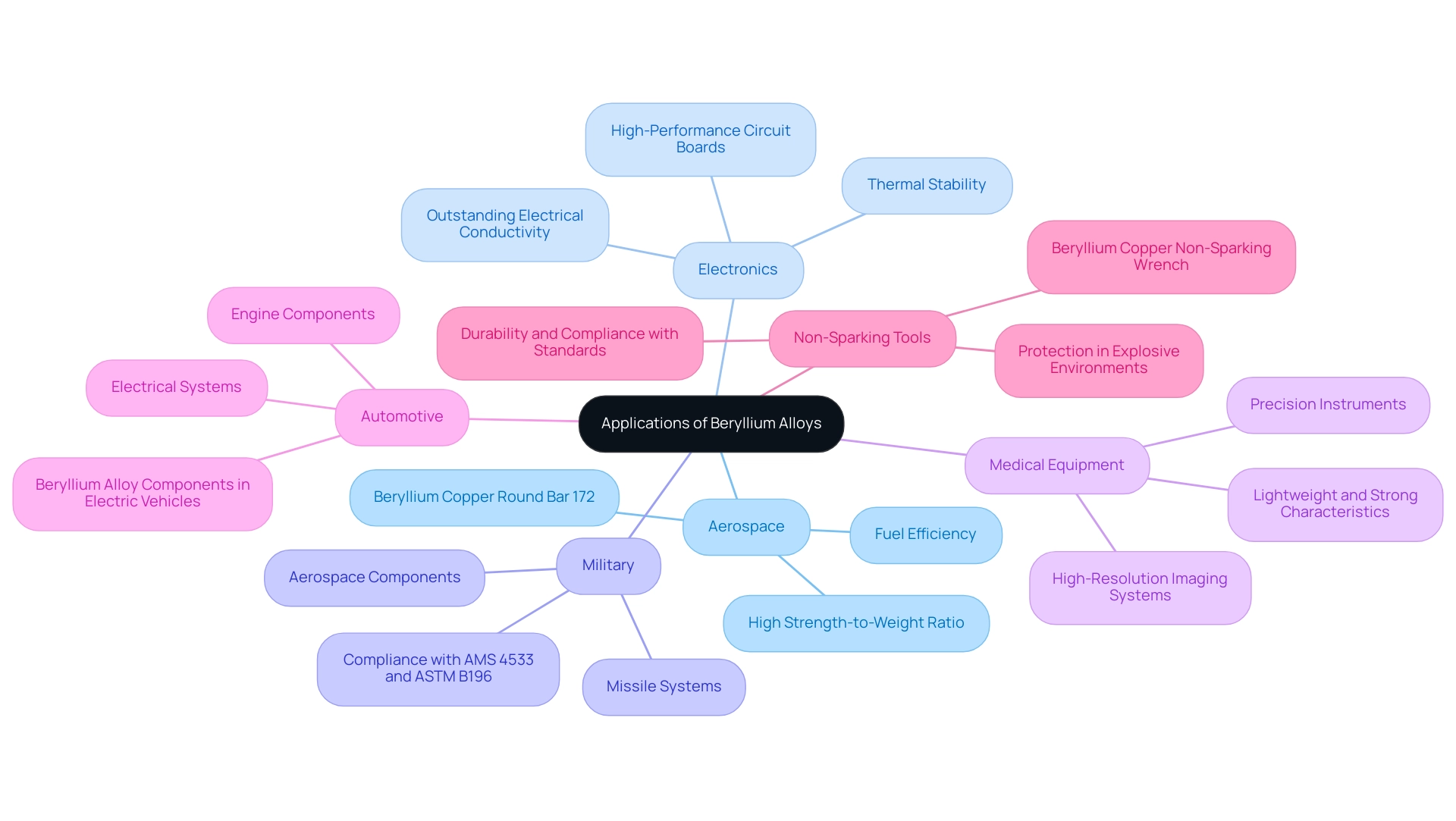
Manufacturing Processes for Beryllium Alloys
The production of beryllium-based materials involves several essential processes, each adding to the final product’s quality and performance. At Domadia, your trusted partner for Beryllium Copper solutions, we ensure that our extensive product range, including foils, sheets, rods, and wires, is tailored to meet your specific requirements and is readily available from our stock:
Casting: This method allows the metal to be molded into various shapes and sizes, providing design flexibility. It’s particularly advantageous for larger components that require precise specifications. Recent advancements in casting methods have enhanced the strength and durability of beryllium-based materials, making them suitable for demanding applications. According to industry reports, modern casting methods have increased yield strength by up to 20%, enhancing performance in high-stress environments.
Powder Metallurgy: This process involves blending a specific metal powder with other metals, followed by compacting and sintering to form the desired shape. Powder metallurgy enables the production of intricate shapes while maintaining stringent dimensional tolerances. Significantly, advancements like the application of high-energy ball milling have improved the mechanical properties and performance of beryllium-based materials, resulting in enhancements in tensile strength and thermal stability.
Machining: Post initial shaping, beryllium-based alloys undergo machining to achieve precise dimensions. This step is critical for applications where high accuracy is paramount. For example, in the automotive sector, the precision machining of specialized components ensures that they meet stringent industry standards. The case study on centerless grinding demonstrated that utilizing such techniques resulted in a 15% reduction in production time while maintaining high-quality standards for automotive components.
Hot Working: Techniques such as forging and extrusion are employed to enhance the mechanical properties of beryllium-based materials through deformation at elevated temperatures. This process enhances the material’s strength and ductility, making it ideal for high-performance applications.
Diligent attention to detail and expertise in handling these specific metals at Domadia ensures that final products meet the desired quality and functional requirements, as highlighted by industry experts at Wisconsin Metal Tech. Additionally, our custom fabrication options allow us to tailor products to meet unique client specifications. By understanding these manufacturing processes and their advancements, procurement professionals can better evaluate potential suppliers’ capabilities, ensuring compliance with quality and production standards.
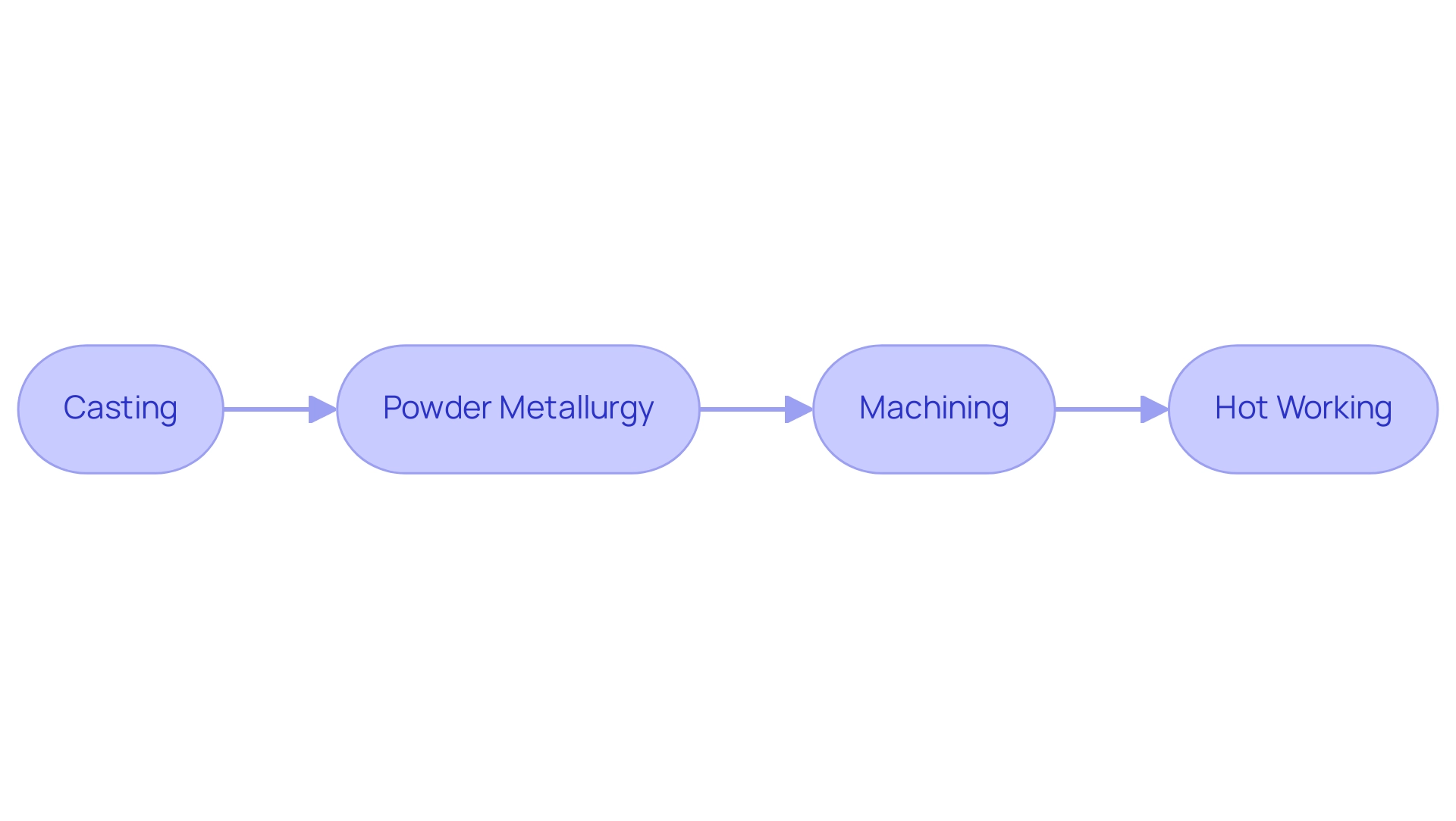
Health and Safety Considerations in Handling Beryllium Alloys
Handling beryllium alloys requires stringent precautionary measures due to the potential health risks involved, particularly in explosive environments. Utilizing Non-Sparking Tools, such as Beryllium Copper Non-Sparking Wrenches, is vital in these settings to prevent ignition hazards. These tools are specifically designed to eliminate the risk of sparks, making them the best alternative for non-sparking applications in explosive environments. Key protection considerations include:
Proper Training: Comprehensive training is essential for all employees, focusing on the risks associated with exposure to the element and the importance of using Non-Sparking Tools. Research indicates that effective risk management training significantly reduces workplace incidents and long-term health issues. Organizations that implemented robust training programs saw a 30% decrease in exposure-related incidents.
Personal Protective Equipment (PPE): The use of PPE, such as gloves, masks, and protective clothing, is crucial to minimize direct exposure. In processing environments, the implementation of PPE protocols has proven effective, as evidenced by reduced health risk indices in various industrial assessments. Facilities adhering to PPE guidelines reported a 40% lower incidence of beryllium-related health issues.
Ensuring that work areas are well-ventilated is critical to mitigating the inhalation of airborne particles during machining and processing. This measure aligns with current health and safety guidelines, which emphasize the importance of controlling airborne contaminants. Effective ventilation systems can reduce airborne concentrations of hazardous materials by up to 50%, significantly lowering exposure risks.
Regular Monitoring: Implementing health monitoring programs for workers exposed to beryllium is vital for early detection of potential health issues. Health Risk Assessments (HRAs) around industrial sites, such as alumina refineries, have demonstrated that continuous monitoring helps maintain hazard indices below risk thresholds, thus protecting worker health. These evaluations have demonstrated that acute and chronic hazard indices are typically below risk thresholds, suggesting minimal health risks to nearby communities.
By following these guidelines and using Non-Sparking Tools, organizations can not only adhere to regulations but also effectively protect their workforce in explosive environments. As Terry RD emphasizes, ‘Experimental production of neurofibrillary degeneration highlights the significance of strict protocols in industrial settings.’ This highlights that without strict precautionary measures, the health hazards linked to handling this element can increase considerably. Through diligent application of these measures, the risks associated with beryllium handling can be significantly minimized. Furthermore, testimonials from industry experts affirm that the use of Non-Sparking Tools is vital in maintaining a secure working environment, reinforcing their role as an essential precaution in explosive settings.
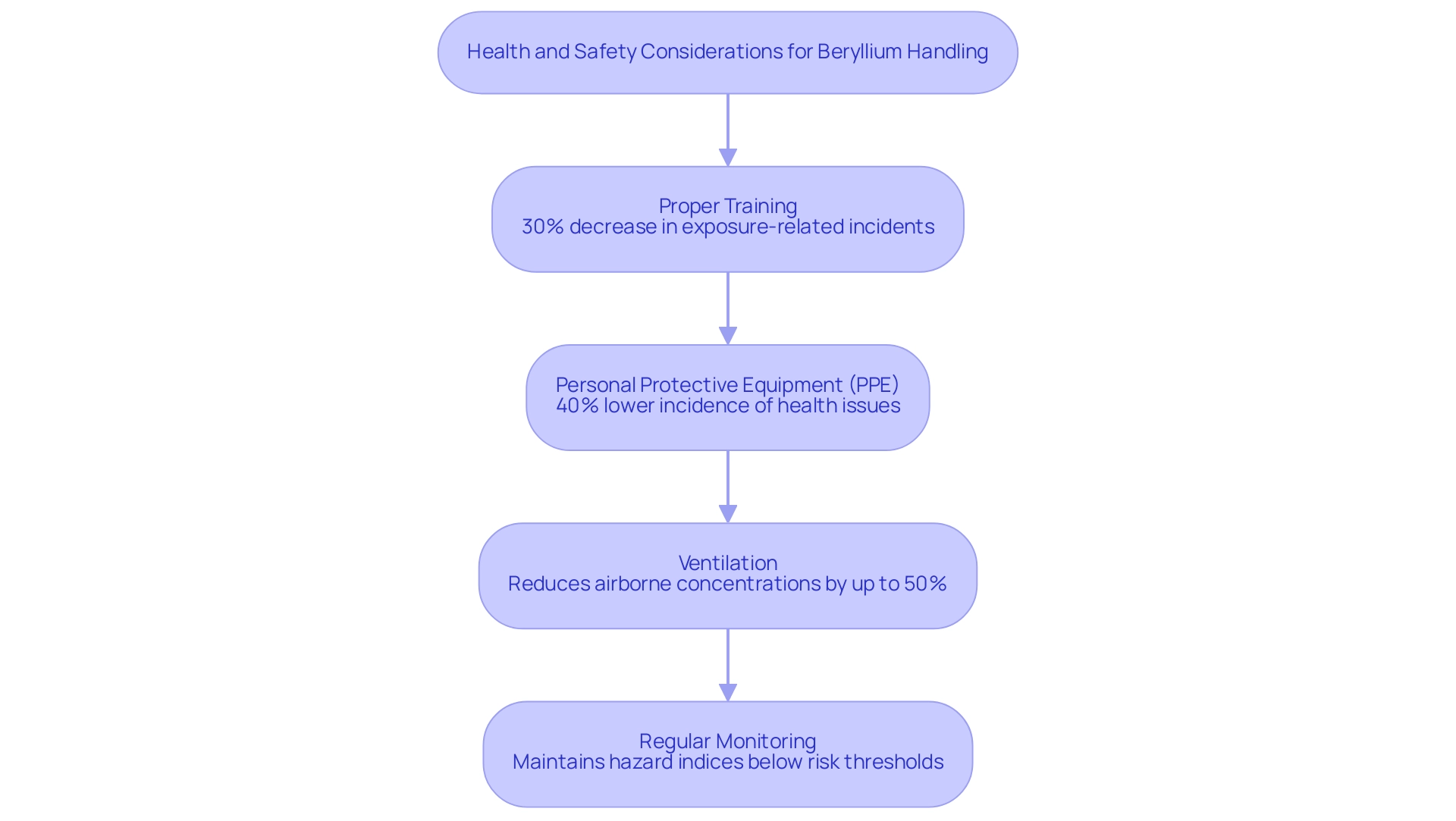
Regulatory Standards and Compliance for Beryllium Alloys
Beryllium alloys are regulated by a set of strict standards to ensure worker protection and environmental preservation, especially in explosive settings where Non-Sparking Tools, like Beryllium Copper Non-Sparking Wrenches, are crucial due to their durability and efficiency in preventing sparks.
Occupational Safety and Health Administration (OSHA): OSHA enforces permissible exposure limits (PELs) for the element to safeguard workers in manufacturing and processing sectors. Recent updates emphasize the necessity of stringent adherence to protective protocols, drawing parallels with the silicosis cases from over-exposure to silica. For instance, OSHA’s current PEL for this substance is set at 0.2 µg/m³, which reflects the agency’s commitment to reducing exposure risks. These cases underscore the critical need for comprehensive training and strict safety measures when handling hazardous materials, particularly when using tools that do not produce sparks. Anticipated updates in 2024 are expected to further refine these exposure limits, ensuring even greater protection for workers.
Environmental Protection Agency (EPA): The EPA’s regulations concentrate on the utilization and disposal of the element, aiming to reduce environmental damage. Real-world implications of these regulations are evident in the extensive survey identifying 2,789 workplaces utilizing this substance, including industries as varied as golf club and bicycle manufacturing. This widespread use necessitates vigilant compliance to avoid environmental contamination. The use of Non-Sparking Tools is essential in these settings to avoid ignition risks, as they are the best option for non-sparking uses.
Global Standards: Entities such as the International Organization for Standardization (ISO) establish guidelines to guarantee the quality and security of alloys across diverse applications, including in Non-Sparking Tools. These standards are crucial for ensuring consistency and security in worldwide commerce and industrial practices.
An expert in public health policy emphasizes,
It would be wise public health policy to terminate the industrial application of this substance, except in those cases where replacement is not feasible.
This statement underscores the importance of considering the entire life cycle of toxic materials in shaping regulatory frameworks. The case study on silicosis from over-exposure to silica illustrates the consequences of insufficient protective measures. This strengthens the case for strict regulatory compliance in the context of handling the metal and the use of Non-Sparking Tools.
Procurement managers must remain well-informed about these regulations to ensure compliance, mitigate risks, and uphold safety standards when sourcing and utilizing beryllium alloys and Non-Sparking Tools. Staying updated on the latest regulatory standards, such as the anticipated 2024 updates, is critical for strategic procurement and risk management.
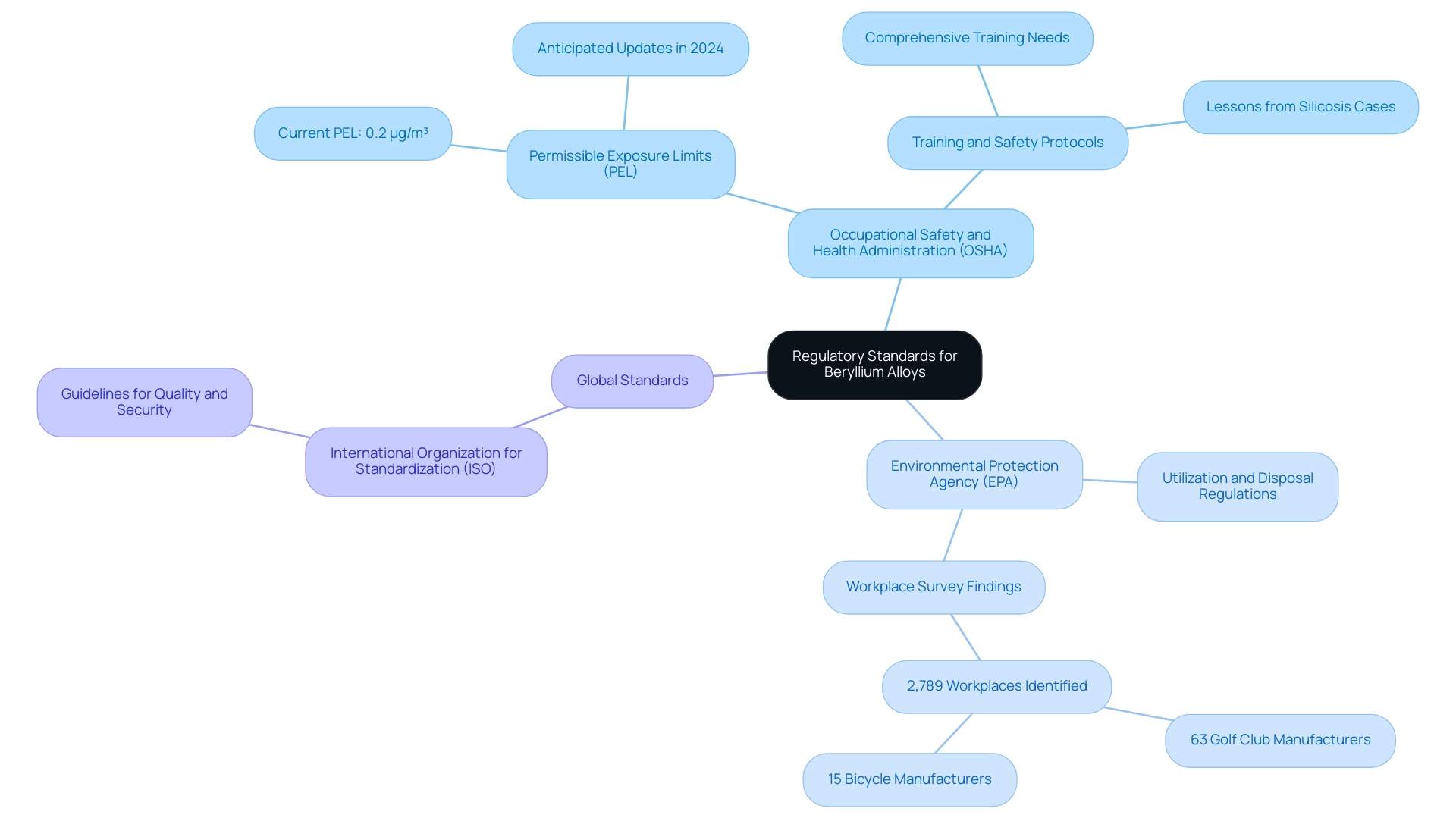
Conclusion
Beryllium alloys, particularly beryllium copper, are crucial in high-performance industries due to their lightweight, strength, thermal stability, and corrosion resistance. These properties make them essential in aerospace, electronics, defense, medical equipment, and automotive applications, where they enhance efficiency and reliability.
The diverse applications of beryllium alloys highlight their versatility, from boosting fuel efficiency in aerospace components to ensuring safety in explosive environments. Understanding the manufacturing processes, such as casting and machining, is vital for securing high-quality materials that meet industry standards.
Health and safety are paramount when handling beryllium alloys. Comprehensive training, personal protective equipment, proper ventilation, and regular health monitoring are necessary to mitigate exposure risks. Compliance with regulations from agencies like OSHA and the EPA is essential to protect workers and the environment, making it crucial for procurement managers to stay updated on these standards.
In conclusion, leveraging beryllium alloys can significantly enhance performance while maintaining safety and compliance. By grasping their properties, applications, manufacturing processes, and safety measures, procurement professionals can make informed decisions that optimize supply chains and contribute to their organizations’ success.




